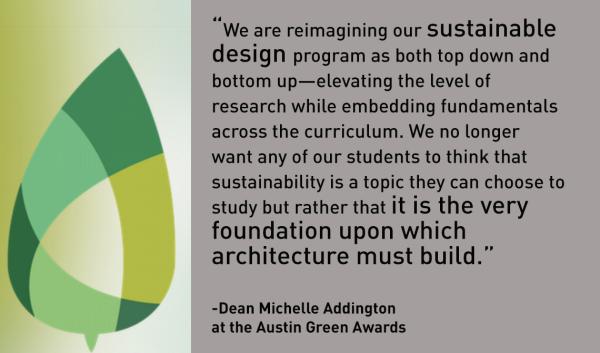Dean Addington Gives Welcome Remarks at Austin Green Awards

On October 25, 2017, Dean Michelle Addington delivered the opening remarks for the second annual Austin Green Awards, held at Waller Ballroom on East Sixth Street.
The Austin Green Awards are Austin's first recognition program specifically for outstanding accomplishments in the broad arena of sustainable design and innovation. They aim to highlight the next generation of sustainably inspired best practices and heighten the visibility of exemplary initiatives in Austin. Awardees set an aspirational bar of what is possible by responding to rapidly evolving environmental, social, and health imperatives.
Among the 4 winners for 2017 was the Milagro Springs Retreat by Miro Rivera Architects, the firm of associate dean Juan Miro.
Read Dean Addington's full remarks below:
I am both honored and delighted to have been asked to provide a few welcoming comments this evening. As some of you may be aware, I am the new dean of the School of Architecture at The University of Texas at Austin. I just started a few months ago. I left the Ivy League after twenty-five years because I wanted to be in this place, at this school, in this city, in this state. For years, when my Harvard and Yale students would ask me where they should go to study or work if they were interested in sustainable design, I always told them—go to Austin. This is where it all began, starting with the Laboratory for Maximum Potential Building Systems, now the Center for Maximum Potential Building Systems who are co-sponsors of this event tonight. The Austin Greenbuilder program, which the Center was instrumental in developing, was the first of its kind and served as the model for what eventually became LEED. The Sustainable Design program at UT Austin was the first and is now the oldest degree program in the United States devoted to Sustainability. The burgeoning growth of neighborhood organizations of the 1970s and 1980s brought grassroots concerns into political discourse, and Austin became one of the first cities in the world to address sustainability as a public service.
For all of these firsts, we now look to what’s next. At the school, we are reimagining our sustainable design program as both top-down and bottom-up—elevating the level of research while embedding fundamentals across the curriculum. We no longer want any of our students to think that sustainability is a topic they can choose to study but rather that it is the very foundation upon which architecture must build. And the higher level research is more important than ever—in an increasingly complex and uncertain world, we must be ever more nimble in finding opportunities to leverage the possible rather than hold out for a tabula rasa optimal that is only meaningful in the abstract.
As we look to our next steps, we want to be very clear that Sustainable Design is Actionable Design. How we test and not just how we evaluate. What results we produce and not just what we predict. What we do and not just what we say.
Sustainability is instrumentalized through buildings, not just about the building, but about building in the public realm. And this point about the public realm is an important one because it takes us back to the original definition of sustainability. In 1987, Gro Harlem Brundtland and her UN Commission argued that our actions to address environmental concerns must always go hand in hand with the greater good of improving the welfare of those most in need. That tenuous balance seemed to get progressively lost as we increasingly defined our subject of interest as circumscribed by property and ownership and we looked inward to focus on our own welfare, or our children’s welfare, rather than that of those beyond our sphere.
Today, Austin steps to the forefront again to show the world how it can be done. Our award winners embody the Brundtland definition of the past to demonstrate our approach to sustainability for the future. Actionable design in the public realm, for the public good.

